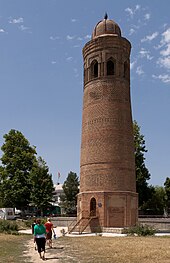Mausoleums from Ösgön
Coordinates: 40 ° 46 ′ 6 ″ N , 73 ° 17 ′ 57 ″ E
The mausoleums of Ösgön are important architectural monuments in Ösgön , a city in the Osh region ( Oblast ) in the Central Asian Republic of Kyrgyzstan .
history
After the Qarakhanid in the years 990-992 large parts of Transoxiana , including the Ferghanatals , the Samanids had conquered, was today uzgen capital of their kingdoms and after Balasagun and next Kashgar and Samarkand one of the four centers of their empire. From Ösgön, Arslan-Ilek Nasr-ben-Ali († 1013), who ruled there from 996, conquered Bukhara , the capital of the Samanids, Samarkand and the rest of Transoxania, in October 999 , and until 1213 Ösgön was the capital of the ruler in the Fergana Valley Branch of the Qarakhanids.
Three well-preserved mausoleums date from this heyday of the city in the 11th and 12th centuries . You are in the archeology-architecture-museum complex, a park-like open space near the city center. The three buildings are built next to each other so that they look like a single building, but they come from different construction periods. They are made of burnt red-brown bricks, with impressive wall and wall ornamentation on the west-facing portal side, and are among the few early Islamic buildings that survived Genghis Khan's conquest of Transoxania in 1219/1220.
description
The oldest and largest of the three is the middle one, the mausoleum of the conqueror of Bukhara and Samarkand, Arslan-Ilek Nasr-ben-Ali († 1013). The 12 m high building has a square floor plan with a side length of around 11.5 m. Ornamental terracotta and carved alabaster with geometric and tendril patterns decorate the front around the portal. This emphasis on the entrance was a new stylistic element at the time. The portal niche is from one to two Blend column resting keel arch spans and decorative friezes with early forms of arabesques , Girikh called includes. The interior, dominated by a small central dome on the otherwise flat roof, has doors on three sides and a niche on the east side and contains some reliefs and friezes with pre-Islamic motifs.
The rectangular mausoleum of Jalal al-Din al-Hussein, which was added to the north in 1152, is characterized by its surface ornaments that adorn the entire facade. It has a footprint of 12.2 × 10.2 m and is about 10.5 m high, also with a flat roof and a small, central dome over the interior. The building is one of the best preserved examples of early Islamic architecture. Not only the entire facade, but also the dazzling columns, the pointed arch, the inside of the portico and the festoon of the portal arch are decorated with fine terracotta patterns. The archivolt of the pointed arch is decorated with Naschī script , the lintel of the portal with Kufi inscription.
For whom the southern mausoleum was built in 1186 is no longer known; it is the smallest of the three, with a height of only about 10 m and an interior space of only 6.4 × 6.4 m, but also the most ornately decorated with ornaments, arabesques and lettering friezes. The portal area contains tapes in naschī and kufi , combined with stars, crosses, flowers and tendrils.
The minaret of Ösgön
About 150 m northwest of the mausoleums, on the north side of the park area, there is a 27.5 m high minaret , probably a model for the minarets built by the Karakhanids in Bukhara and Vobkent . The upper part of the originally much higher and at its base 8.5 m wide, still tapering tower was destroyed in an earthquake in the 16th century. Today it is crowned by a dome above a viewing platform.
literature
- Thomas Scholl: Kyrgyzstan: To the peaks of Tien-Shan and Pamir. 3rd edition, Trescher Verlag, Berlin, 2009, ISBN 978-3-89794-139-7 , pp. 159-160
- Robert Hillenbrand: Islamic Architecture. Edinburgh University Press, Edinburgh, 1999, pp. 294, 530.
- Edgar Knobloch: Monuments of Central Asia. IB Tauris Publishers, London, 2001, pp. 155, 163, 164.


